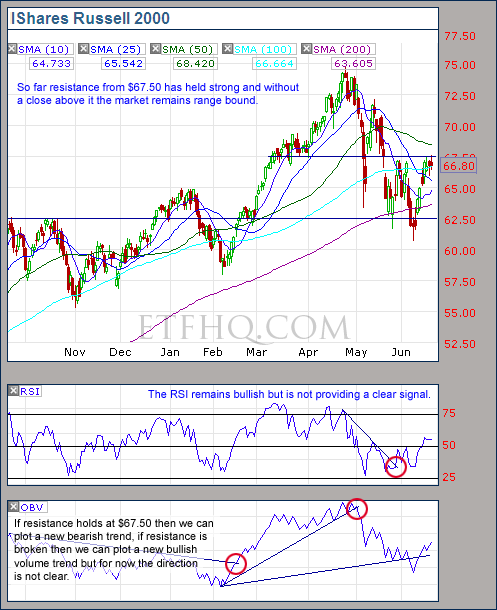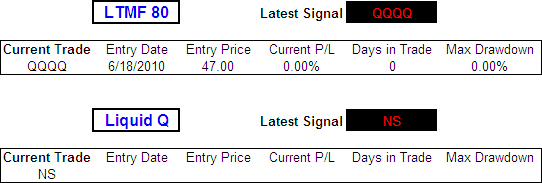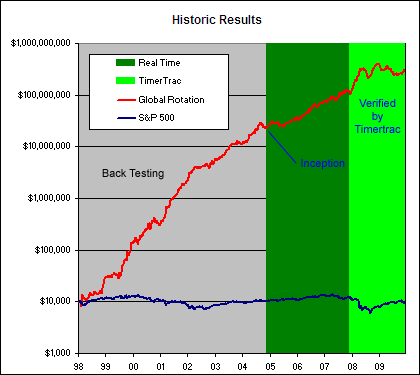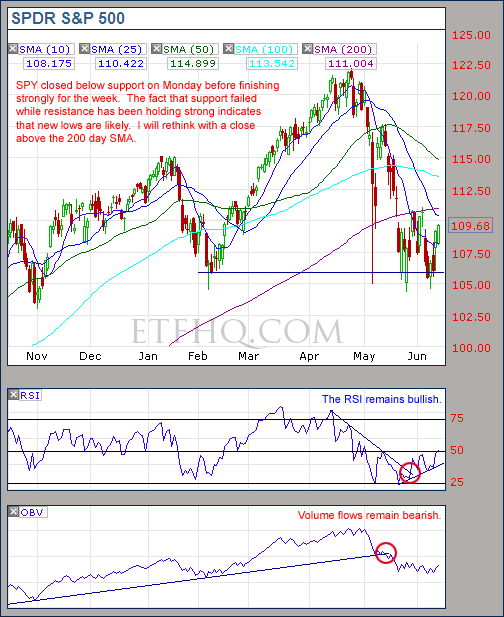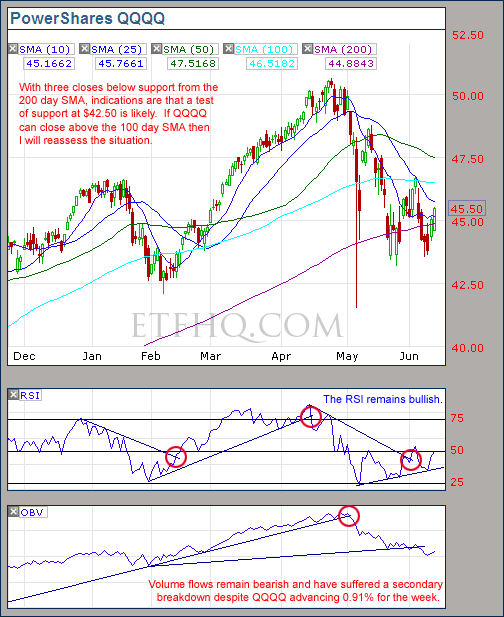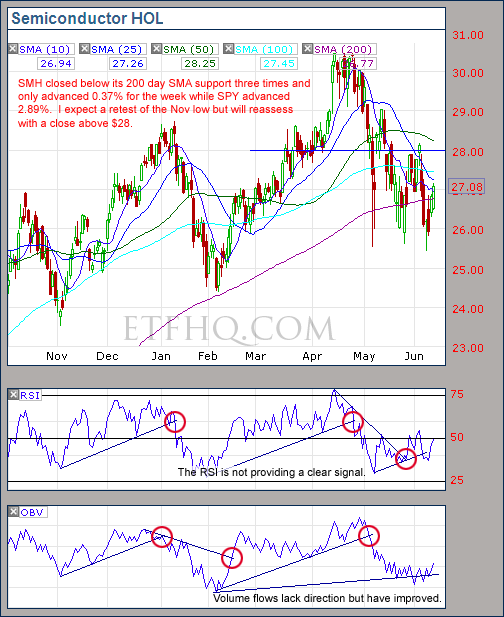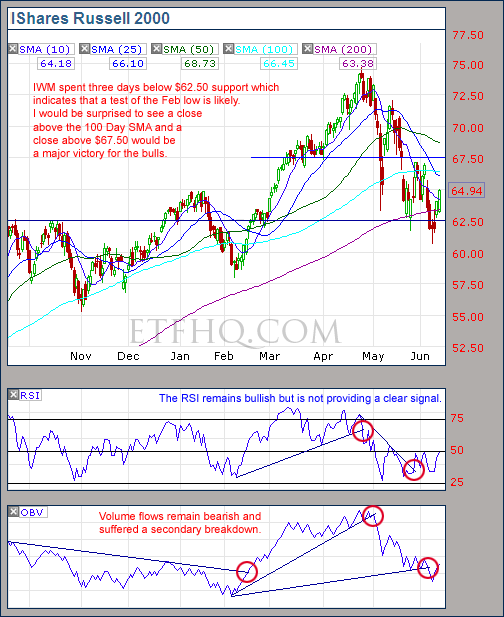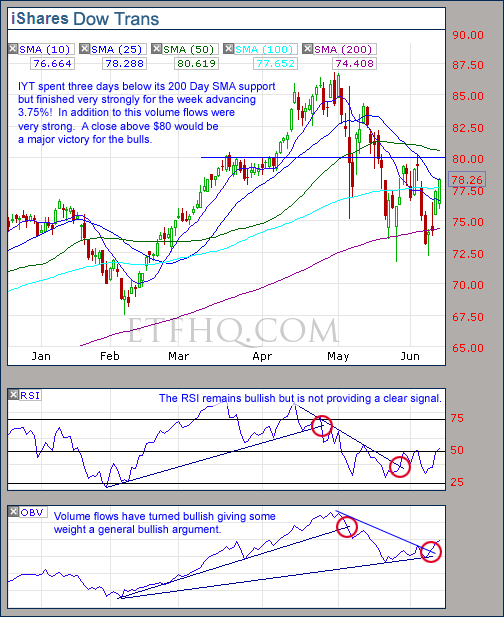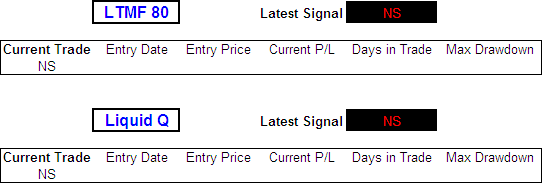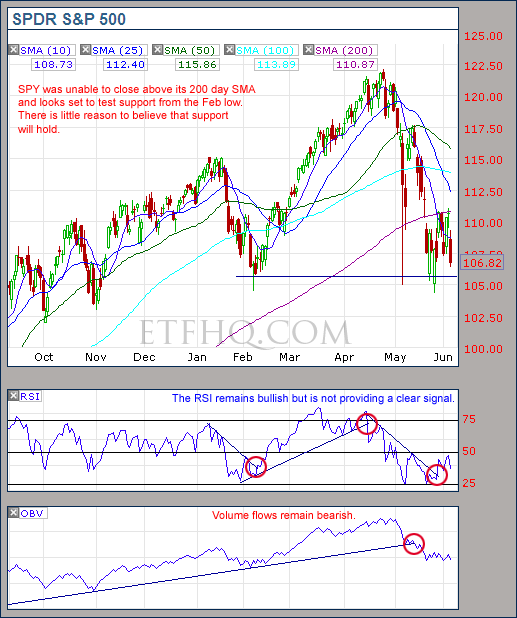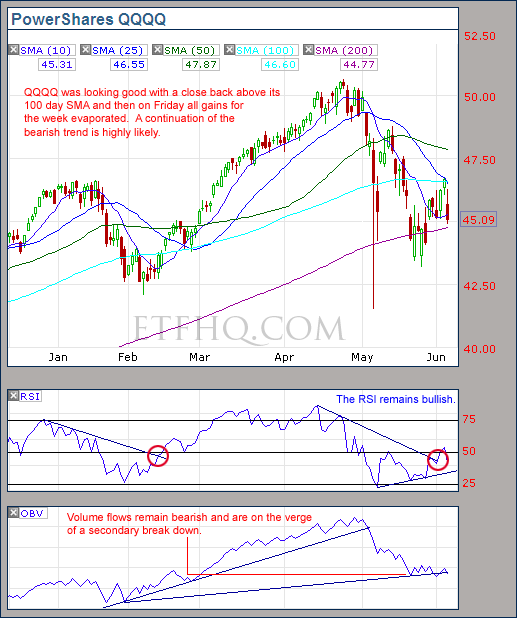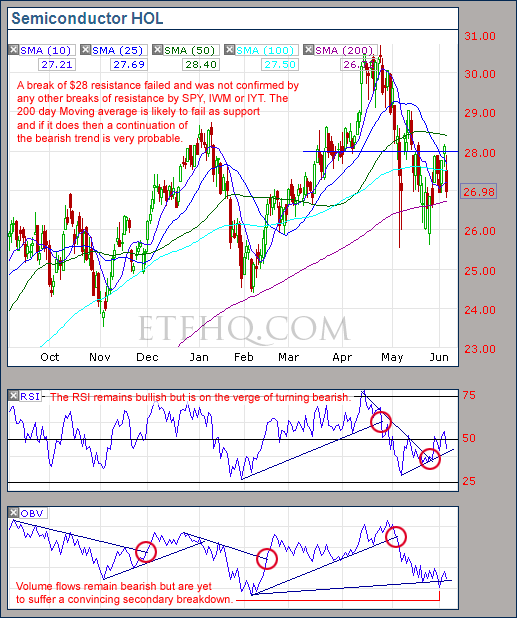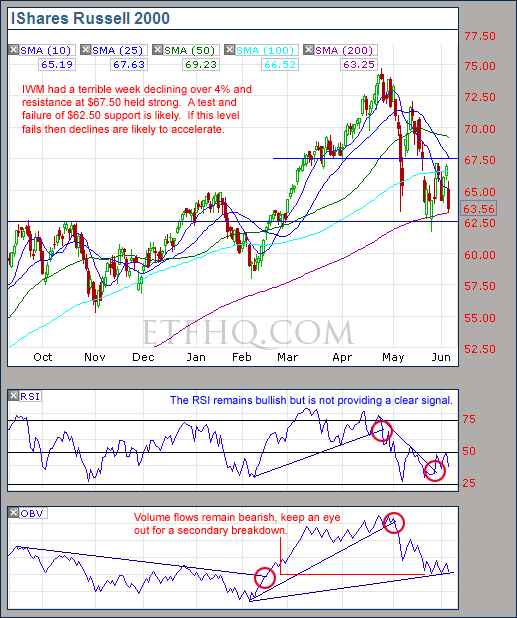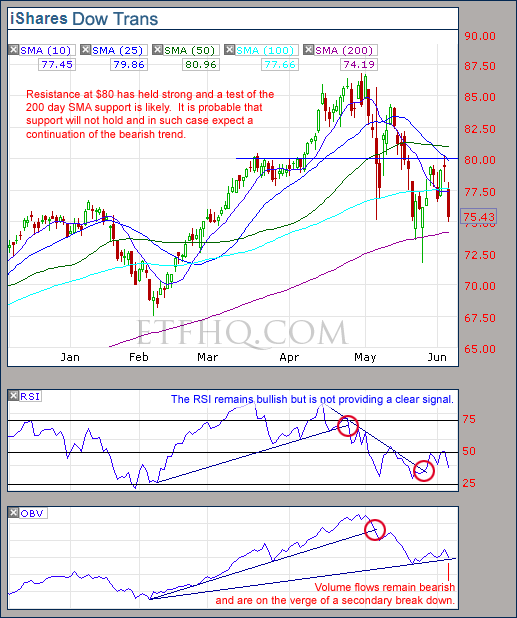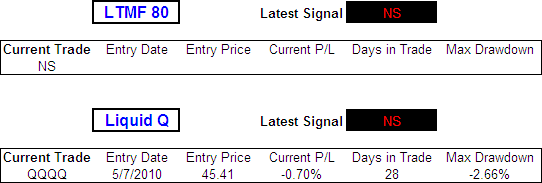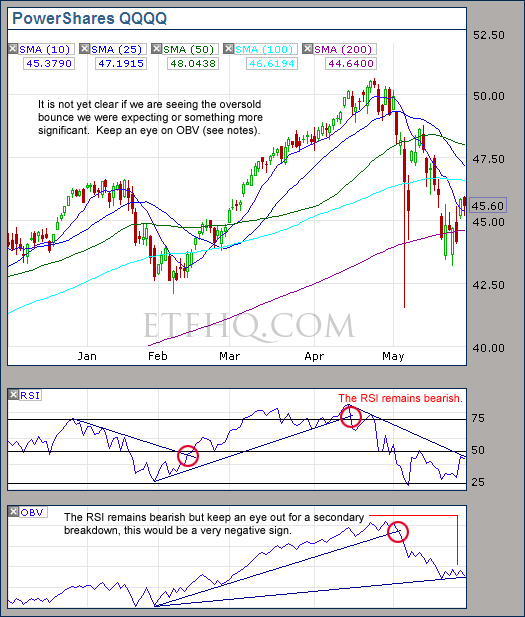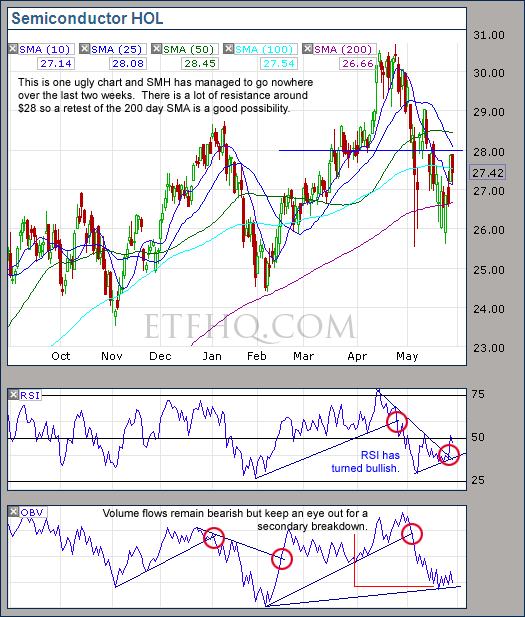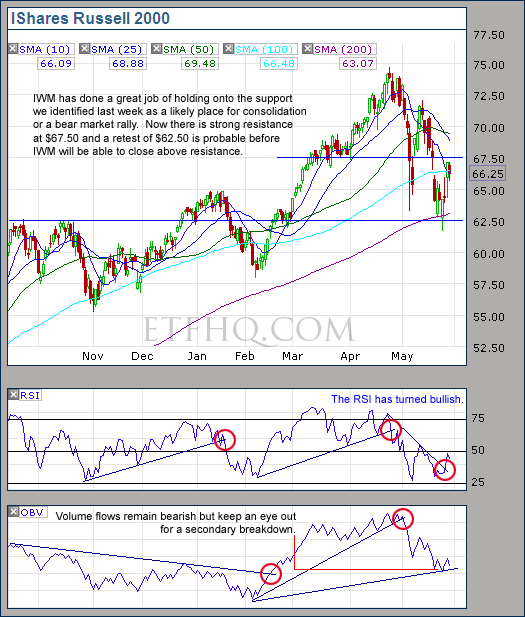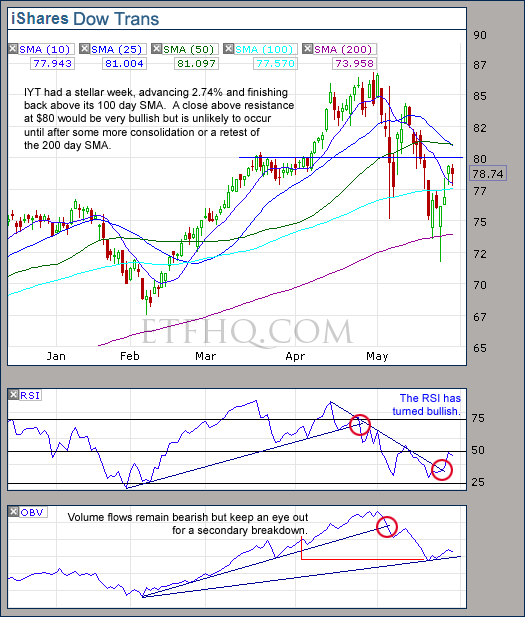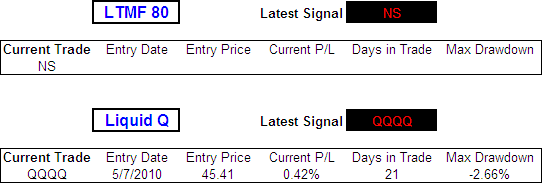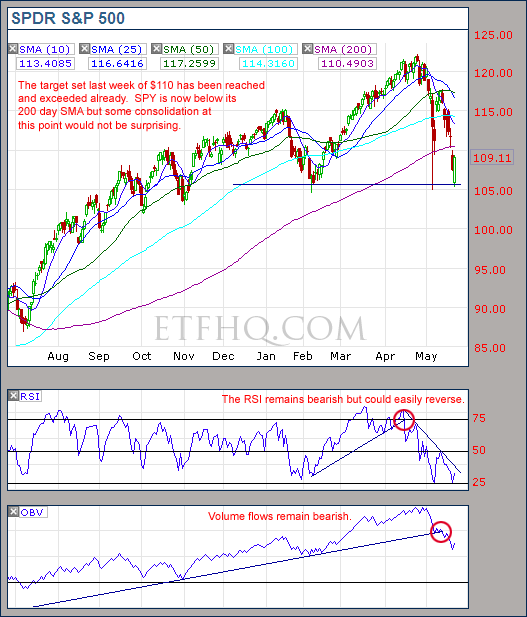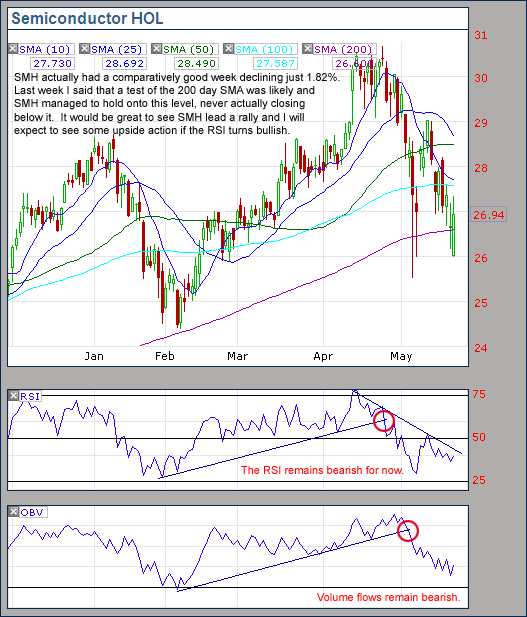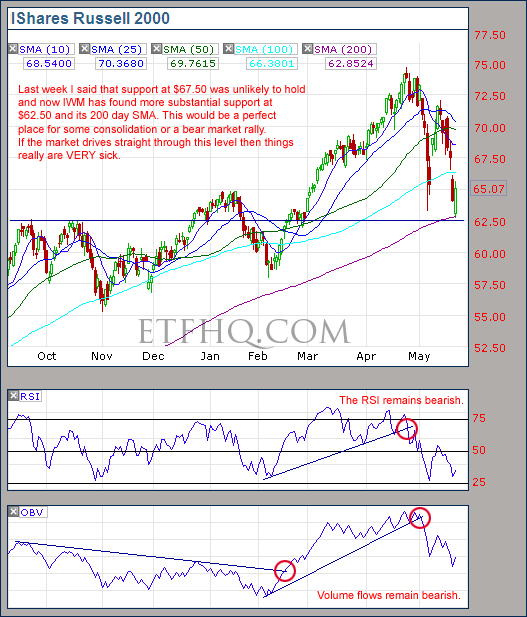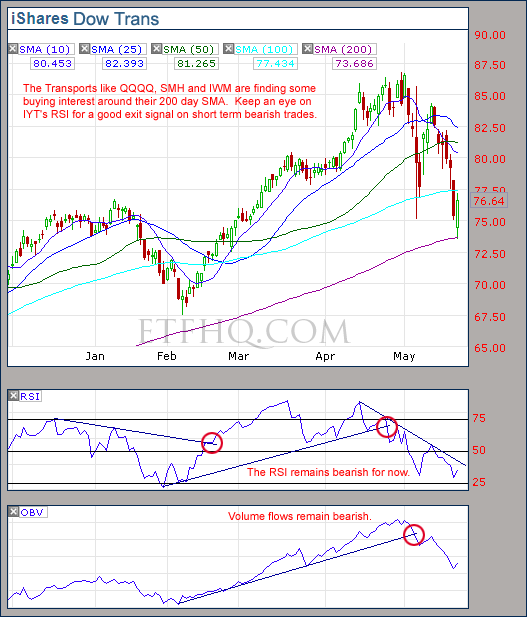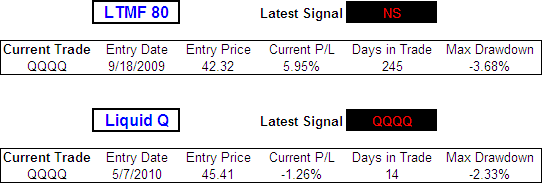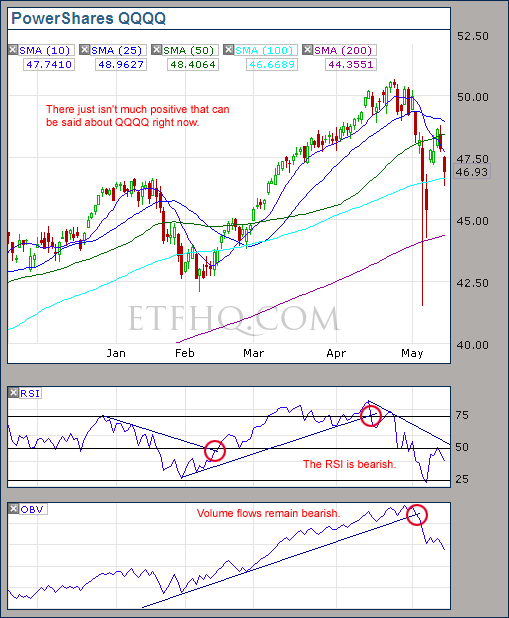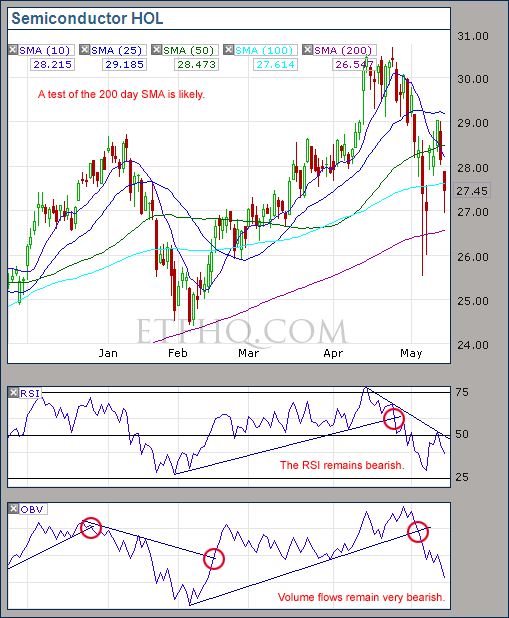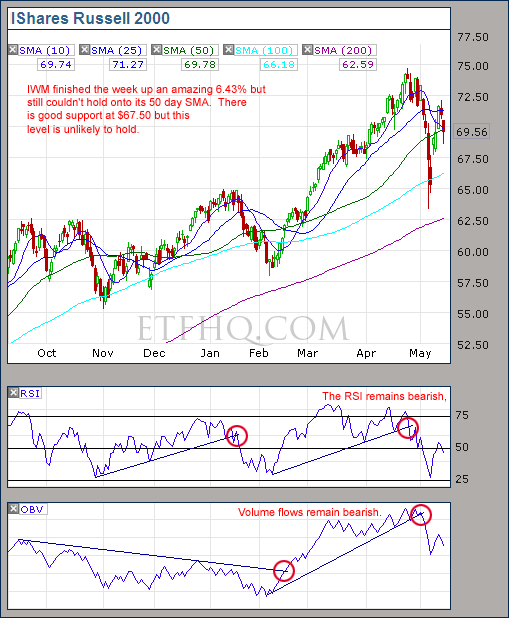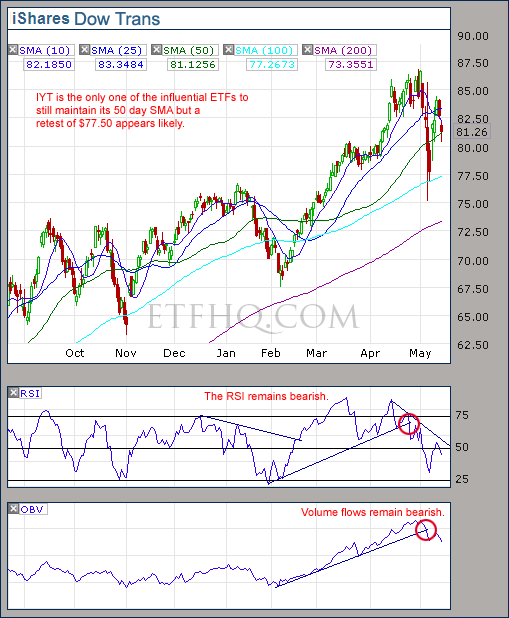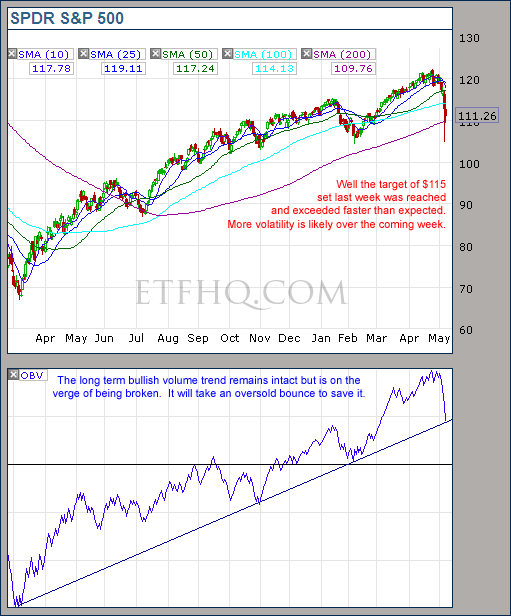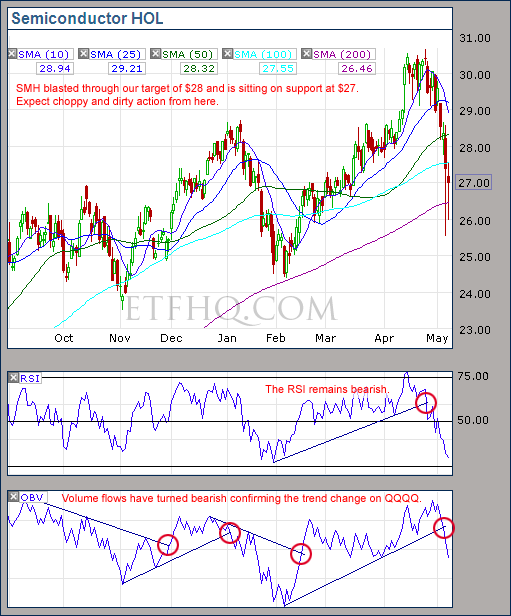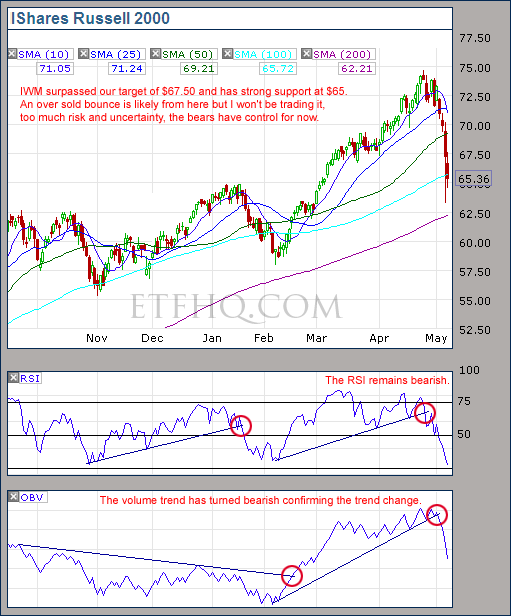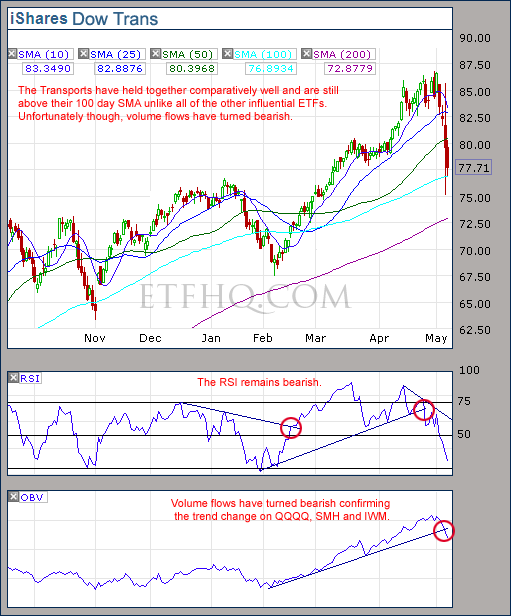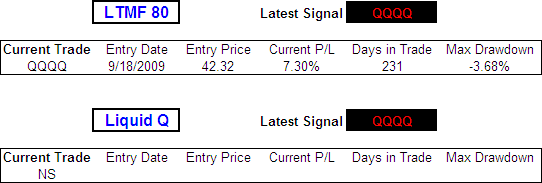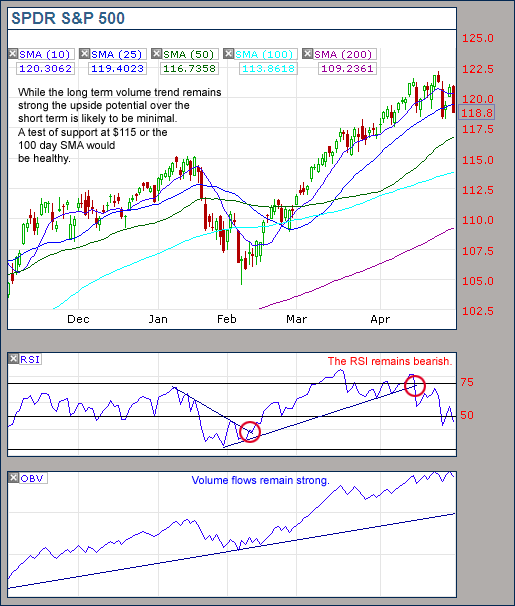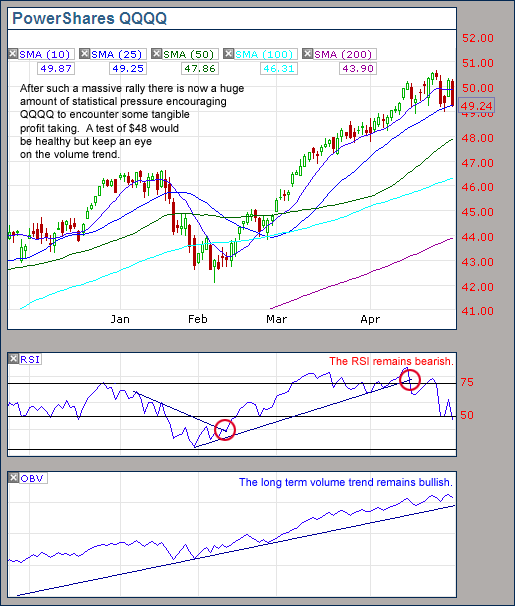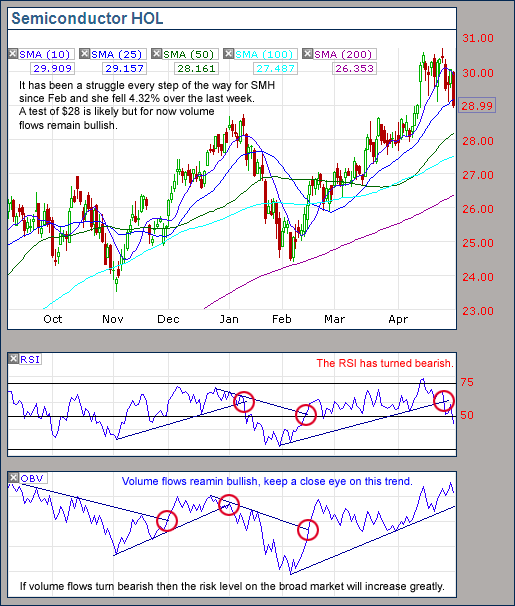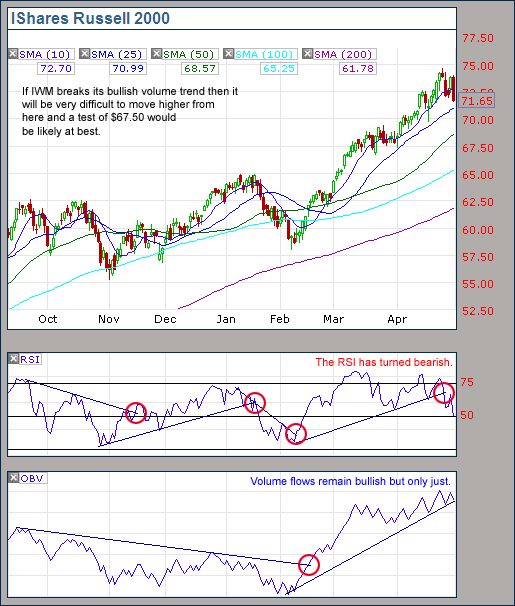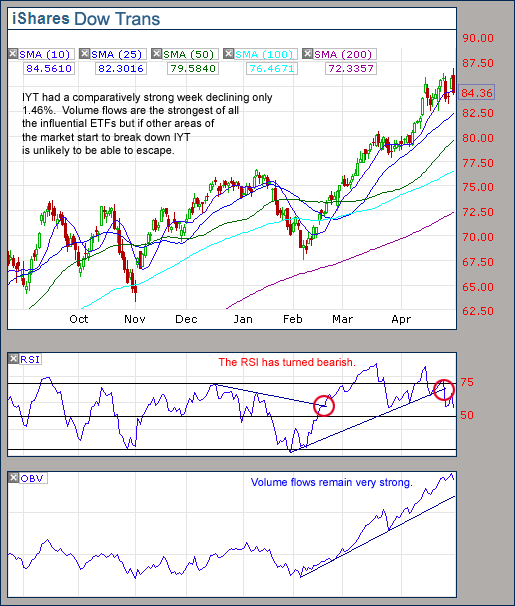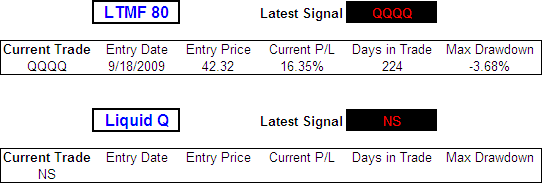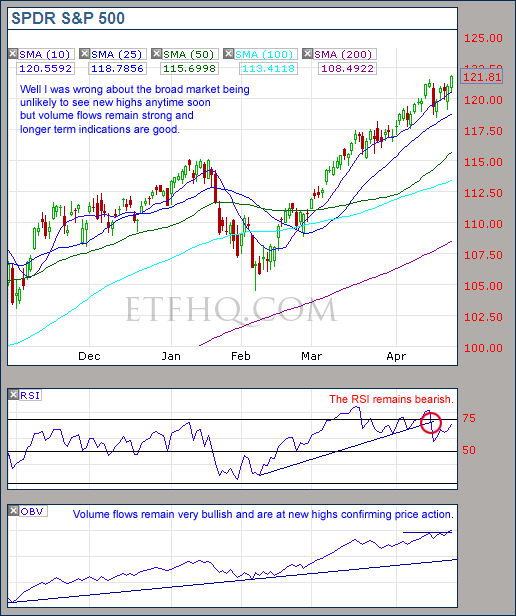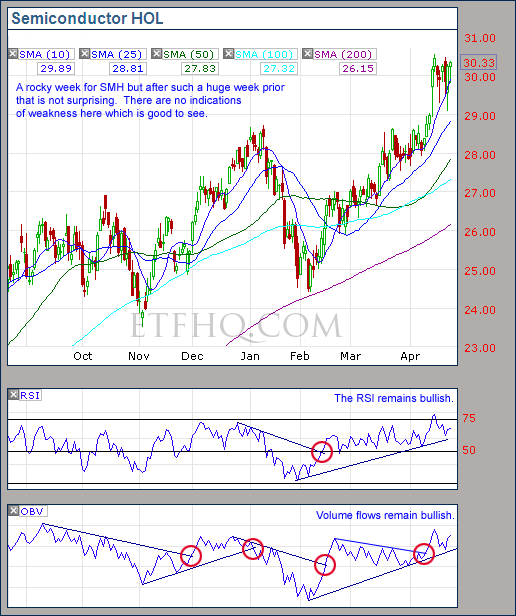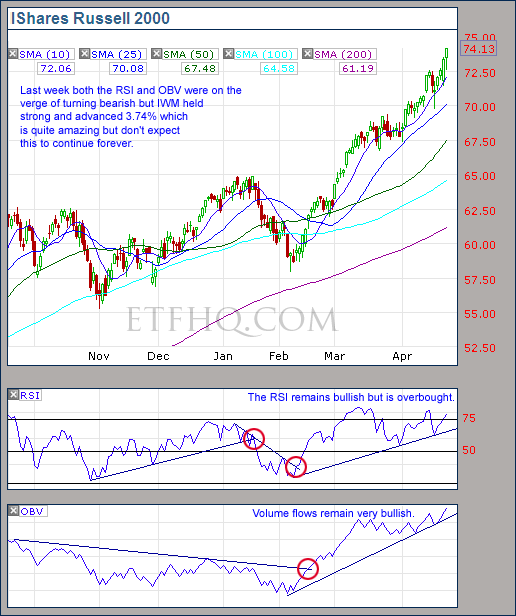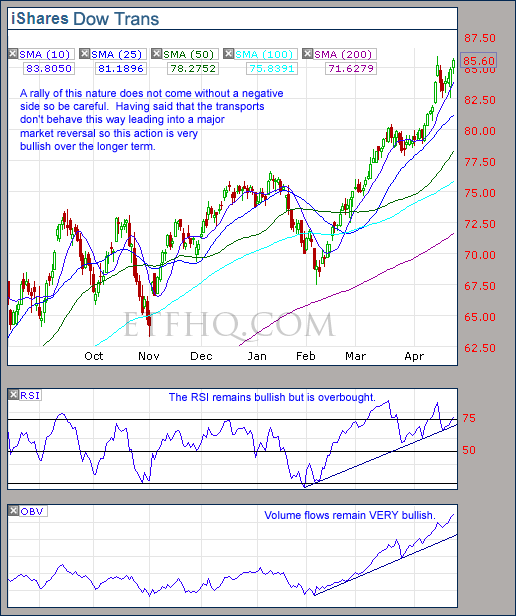June 27, 2010 – 11:25 pm EDT
The market failed at every one of the resistance levels that needed to be broken in order to indicate a return to the bull market. As a result the market remains range bound but there have been several bearish developments to suggest that we are soon to see a continuation of the bearish trend we identified at the beginning of May.
.
ETF % Change Comparison
.

SMH and IYT were the top performers over the last week and all but the Dow are now (once again) over 10% from their recent highs. Over the last four weeks however the market has basically gone nowhere.
.
What the % Comparison Table Tells Us:
By comparing the performance of the economically sensitive (SMH, QQQQ, IWM, IYT) and the comparatively stable ETFs (SPY and DIA) we can get an indication of the true market direction. The more sensitive areas of the market tend to be the first to initiate a trend change. For example if DIA and SPY sell off heavily while SMH and IWM (Russell 2000 small cap ETF) sell of mildly or continue moving to new highs then this would be very positive and vice versa.
The ‘Average Rank %’ is calculated by subtracting the % change for each ETF from the maximum % change and dividing it by the range for each period. 1-((MAX(% change all ETFs)-ETFs % Change)/(MAX(% change all ETFs)-MIN(% change all ETFs))) The readings for each period are then averaged. This reading is provided because if one ETF was significantly under/out performing the others then a plain high or low rank would not accurately reflect this.
.
![]()
.
A Look at the Charts
.
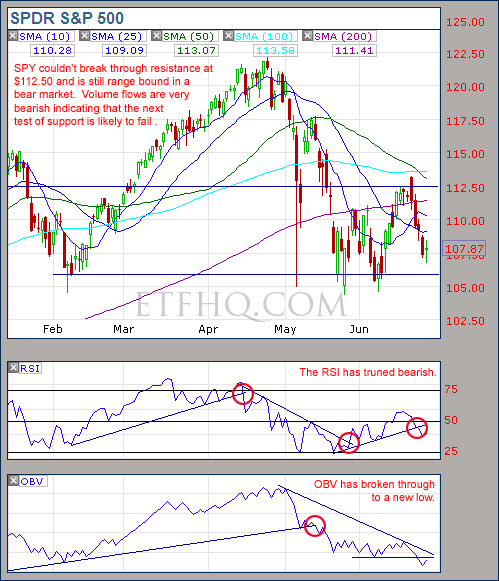
The fact that OBV has moved to a new low is a strong warning that support is likely to fail on SPY.
.
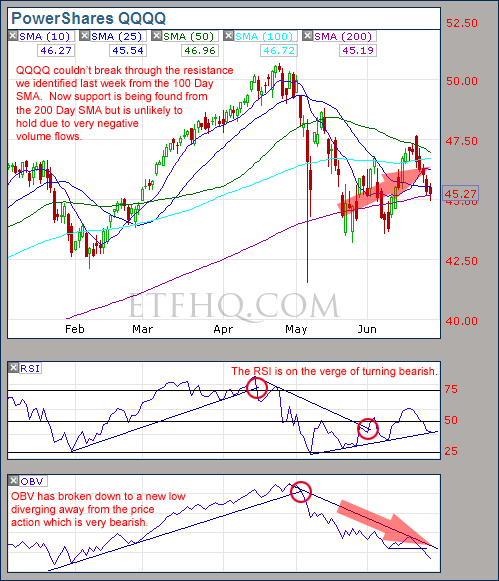
It is very negative to see volume flows diverging from the price action in this way.
.
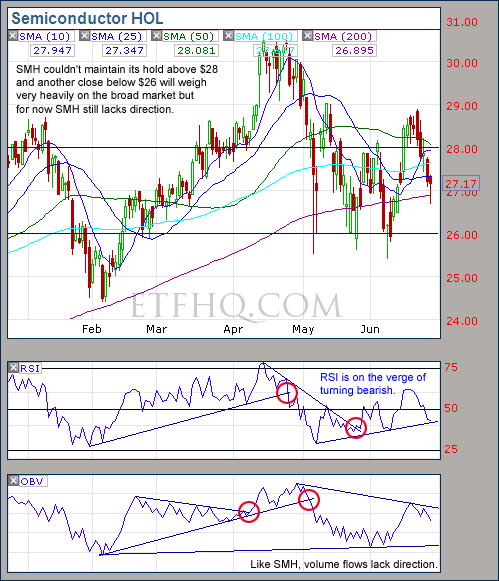
SMH has no real direction in its volume flows but they are still far more positive than that of SPY and QQQQ. A close below $26 would be hard to recover from this time.
.
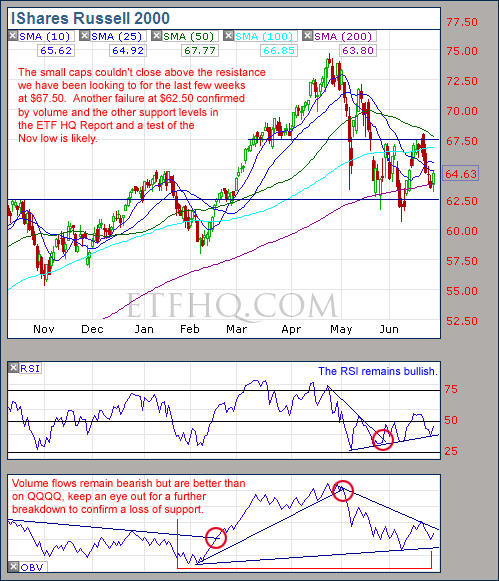
IWM is still range bound in a bearish market, look for either a further breakdown or trend change from OBV.
.
The Transports continue to hold onto their bullish volume trend, this will need to be broken to confirm a continuation of the bear market.
.
![]()
.
OM3 Weekly Indicator
.

Sell Signals across the board indicating that the trend remains bearish while the Bull Alerts show that the weekly cycle is still on the way up.
.
How to read the OM3 indicator
The OM3 indicator as with most of our models primarily reads price action and volume. The strong/weak buy/sell signals are self-explanatory. ‘No Signal’ means that the component readings are in conflict and cancel each other out.
The alerts let you know if the cycle is speeding up or slowing down, so when you get at ‘Strong Buy, Bear Alert’ for instance it simply means that the criteria for a strong buy is in place but this weeks cycle reading is weaker (or more bearish) than last weeks reading (the same is true in reverse).
The number of weeks that a signal has been repeated is displayed. Historically a ‘Strong Buy’ signal has lasted for an average of 6 weeks and a maximum of 42 weeks, while a ‘Strong Sell’ has lasted for an average of 4 weeks and a maximum of 16.
This is an indicator not a mechanical trading model. It is useful to assist in analyzing the market but for the best results should be combined with commonsense and support/resistance levels etc.
.
![]()
.
TransDow & NasDow
.
The Dow has gained dominance over the Transportation Index for the first time in 119 days thus closing out this trade for a rather uninspiring return of 2.58%. For the NasDow there continues to be no clearly dominant market. This indicates a rise in risk levels; historically the market has been very unproductive under these conditions and has seen the majority of it’s major declines.
.
What the TransDow Readings tell us:
The TransDow measures dominance between the DJ Transportation Index (DJTI) and the Dow Jones Industrial Average (DJIA). In a strong market the more economically sensitive Transportation Index should be dominant over the DJIA.
Historically the DJTI has been dominant over the Dow 45% of the time. The annualized rate of return from the DJTI during this period was 18.47% with the biggest loss for one trade sitting at -13.27%. The annualized return from the DJIA during the periods it was dominant over the DJTI was just 4.06% and the biggest loss for one trade was -16.13%. A 4% stop-loss is applied to all trades adjusting positions only at the end of the week.
What the NasDow Readings tell us:
The NasDow measures dominance between the NASDAQ and the DJIA. Using the same theory behind the Trans Dow; in a strong market the more economically sensitive NASDAQ should be dominant over the DJIA.
Historically the NASDAQ has been dominant over the DJIA 44% of the time. Taking only the trades when the NASDAQ is above its 40 week moving average the annualized rate of return was 25.47% with the biggest loss for one trade sitting at –8.59%. The annualized rate on the DJIA during the periods it was dominant over the NASDAQ is just 8.88% and the biggest loss for one trade was –12.28%. A 8% stop-loss is applied to all trades adjusting positions only at the end of the week.
.
![]()
.
LTMF 80 & Liquid Q
.
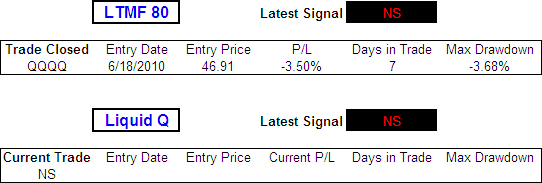
LTMF 80 closed its position in QQQQ after just one week for a 3.5% loss. Liquid Q remains in cash.
.
Historical Stats:
.

.
How The LTMF 80 Works
LTMF stands for Long Term Market Forecaster. It reads volume flows relative to price action and looks for out performance of volume measured on a percentage basis over the prior 12 months. During a sustained rally the readings will reach high levels (near 100%) making it imposable for the volume reading to always outperform price so any reading above 80% will maintain the buy signal. This system has outperformed the market over the last 10 years but performance has been damaged by some nasty losses. It only produces buy signals and only for QQQQ.
How Liquid Q Works
Liquid Q completely ignores price action and instead measures the relative flow of money between a selection of economically sensitive and comparatively stable ares of the market. It looks for times when the smart money is confident and and can be seen by through volume investing heavily is more risky areas due to an expectation of expansion. This system has outperformed the market over the last 10 years and remained in cash through most of the major declines. It only produces buy signals and only for QQQQ. We will provide more performance details on the web site for these systems soon.
.
![]()
.
Summary
.
At first glance little appears to have changed over the last week as the battle between support and resistance rages on. However on closer inspection volume flows on SPY and QQQQ have deteriorated and are significantly under performing the price action. This indicates that a continuation of the bearish trend will soon begin but this still needs confirmation from the following areas:
- QQQQ close below 200 Day SMA and a bearish RSI
- IWM close below $62.50 with a bearish RSI and a further break down of OBV
- IYT close below 200 Day SMA with a bearish RSI and bearish OBV
One reader kindly left some interesting feedback in the Testimonials section suggesting that these reports are confusing. What are your thoughts on this?
I have been meaning to finish the book explaining my methodology fully which should clarify matters but any ideas on how we can improve these reports would be much appreciated. It has been very challenging to identify the market direction over the last month because… well, there hasn’t been one. The process we go through in these reports I call ‘Holistic Market Analysis’ and although it is more involved than regular technical analysis, is has allowed us to avoid getting the false readings that would have come by only looking for confirmation of the trend from one area of the market.
.
Any disputes, questions, queries, comments or theories are most welcome in the comments section below.
.
Derry
And the Team @ ETF HQ
“Equipping you to win on Wall St so that you can reach your financial goals.”
.
P.S Like ETFHQ on Facebook – HERE
.
![]()
.
Quote of the Day:
“It is not the critic who counts; not the man who points out how the strong man stumbled, or where the doer of deeds could have done better. The credit belong to the man who is actually in the arena; whose face is marred by dust and sweat and blood; who strives valiantly; who errs and comes short again and again. Who knows the great enthusiasms, the great devotions, and spends himself in a worthy cause. Who at the best knows in the end the triumph of high achievement; and who at the worst, if he fails, at least fails while daring greatly. So that his place shall never be with those cold and timid souls who know neither victory nor defeat.” – Theodore Roosevelt (“The Man in the Arena”)

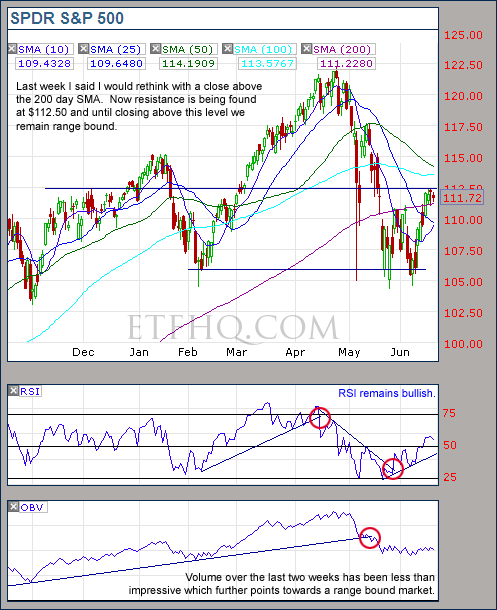
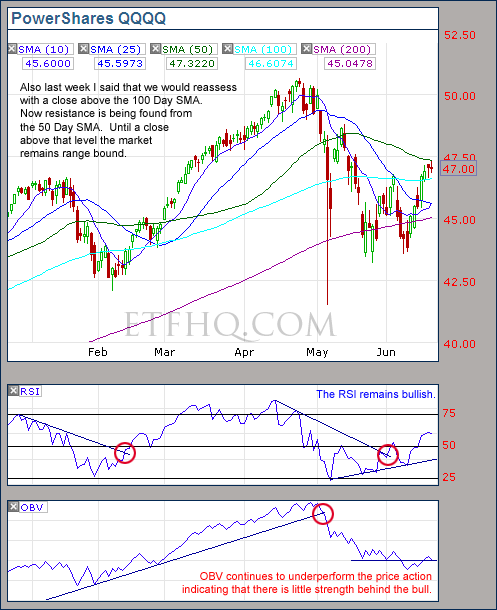
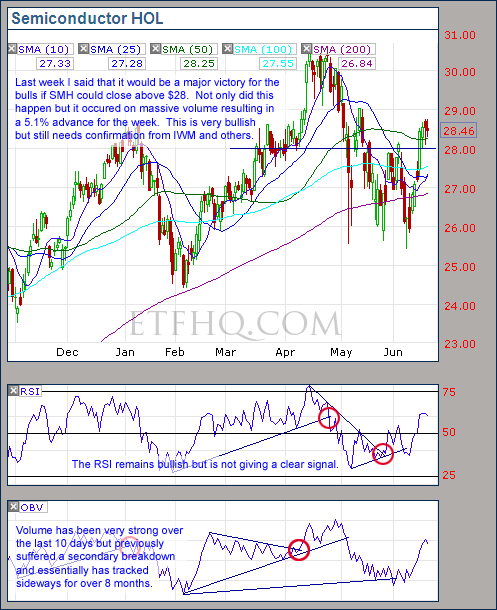 .
.